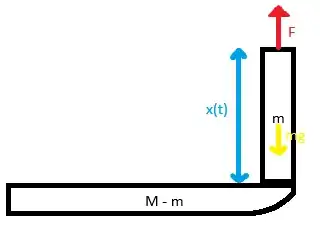Suppose there's a non-stretchable rope sitting on a flat surface with total mass $M$ and length $L$. You pull one end upward with a constant force $F$. The part above the surface has mass $m$ and length $l$. Ignore thickness and friction. What is the differential equation that describes $l(t)$?
Original question: "A uniform 10-foot-long heavy rope is coiled loosely on the ground. As shown in FIGURE 1.R.2 one end of the rope is pulled vertically upward by means of a constant force of $5$ lb. The rope weighs $1$ lb/ft. Use Newton's second law in the form given in (17) in Exercises 1.3 to determine a differential equation for the height $x(t)$ of the end above ground level at time $t$. Assume that the positive direction is upward"
Attempt
Newton's Second Law states that $F_{net}=\frac{d}{dt}[mv]$. The net force acting on the upper part (part above the surface) is $F_{net}=F - mg$ where we take the positive direction to be upward. The RHS becomes $\frac{dm}{dt} v + m\frac{dv}{dt}$. Assuming the rope has a constant density, $m=\frac{M}{L}l$.
$F - mg = \frac{dm}{dt} v + m\frac{dv}{dt}$
$F - mg = (\frac{M}{L}\frac{dl}{dt}) (\frac{1}{2}\frac{dl}{dt}) + (\frac{M}{L}l)(\frac{1}{2}\frac{d^2l}{dt^2})$
$\frac{M}{2L}(\frac{dl}{dt})^2+\frac{Ml}{2L}\frac{d^2l}{dt^2}+mg-F=0$
The reason why there's a $\frac{1}{2}$ is because the motion is of the center of mass; since $x_{CM} = \frac{l}{2}$, $v_{CM} = \frac{1}{2}\frac{dl}{dt}$ and $a_{CM} = \frac{1}{2}\frac{d^2l}{dt^2}$. The textbook seems to agree with my final equation but not about the $\frac{1}{2}$. I tried searching things up but it just seems to skip the fact that the center of mass and therefore its motion is half the length $l$. Am I wrong about something? Is it special that it is a rope? Is the textbook wrong?
Text: Advanced Engineering Mathematics 6th ed., Dennis G. Zill, Chapter 1 "Chapter in Review" problem 43

